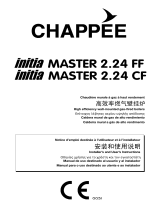Standards and regulations
Note: Please read these instructions carefully before
the installation and keep them in a safe place.
Please also note the technical information in
the appendix.
Any damage or loss resulting from technical
modications to the control unit or to the control
components are excluded from our liability.
Incorrect use can lead to a risk to life and limb
or to a risk of material losses.
Only use propane compliant with local
regulations, otherwise faults may arise through
the starting characteristics and operation of the
gas condensing boiler; this in turn may lead to
boiler damage and risk of injury. Poorly vented
LPG tanks can lead to ignition problems. In such
cases, contact your local LPG supplier.
Note: Please read these instructions carefully before
the installation and keep them in a safe place.
Please also note the technical information in
the appendix.
Requirements
The installation of the boiler must be in accordance with the
relevant requirements of Gas Safety (Installation and Use)
Regulations 1998, Health and Safety Document No. 635 (The
Electricity at Work Regulations 1989), BS 7671 (IEE Wiring
Regulations) and the Water Supply (Water Fitting) Regulations
1999, or The Water Bylaws 2000 (Scotland). It should also
be in accordance with the relevant requirements of the Local
Authority, Building Regulations, including amendments to
the Approved Documents Part L and J 2002, The Building
Regulations (Scotland), The Building Regulations (Northern
Ireland) and the relevant recommendations of the following
British Standards:
BS 5440: Flues and ventilation of gas red boilers not
exceeding 70 kW net:
- Part 1: Flues
- Part 2: Ventilation
BS 5449: Specication for forced circulation hot water for
domestic premises.
BS 5546: Specication for forced circulation hot water for
domestic premises.
BS 6700: Services supplying water for domestic use within
buildings and their curtilages.
BS 6798: Specication for installation of gas red boilers
not exceeding 60 kW input.
BS 6891: Specication for installation of low pressure gas
pipework up to 28 mm (R1") in domestic premises
(2
nd
family gas).
BS 7593: Treatment of water in domestic hot water central
heating systems.
Institute of Gas Engineers Publication IGE/UP/7/1998:
"Guide for gas installations in timber framed housing"
Important: The appliance must be installed and serviced by
a competent person as stated in the Gas Safety (Installation
and Use) Regulations 1998. In IE, the installation must be
in accordance with the current edition of I.S,813 "Domestic
Gas Installations", the current Building Regulations and
reference should be made to the current ECI rules for electrical
installation.
When tightening or loosening threaded connections always use
suitable open-ended spanners (not pipe wrench, or extensions,
etc.). Incorrect use and/or unsuitable tools can lead to damage
(e.g. gas or water leaks)!
Any damage or loss resulting from technical
modications to the control unit or to the control
components are excluded from our liability.
Incorrect use can lead to a risk to life and limb or
to a risk of material losses.
Obtain the permission of your mains gas supplier and ue
gas inspector prior to the installation of Wolf gas red
boilers [where appropriate].
Wolf gas red boilers must only be installed by a recognised
heating contractor. This heating contractor will also be
responsible for the correct installation and commissioning of
the heating system.
The following regulations, rules and guidelines must be
observed during installation:
- VDE 0722 / EN50165 Electrical equipment of heat
generators with non-electrical
heating systems
- DIN EN 12828 Heating systems in buildings,
designing hot w ater heati ng
systems
- EN 60335-1 Safety of electrical equipment for
domestic use and similar purposes
-
VDE 0470 / EN 60529
Protection through housings





















